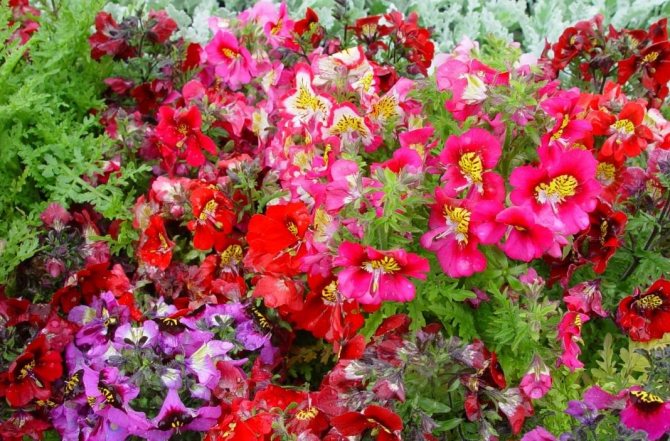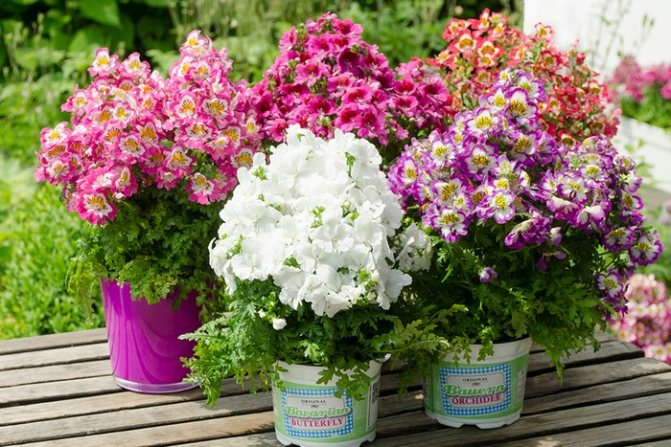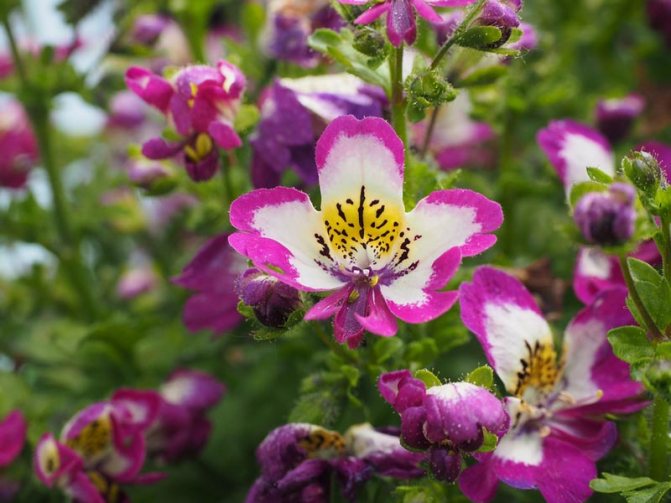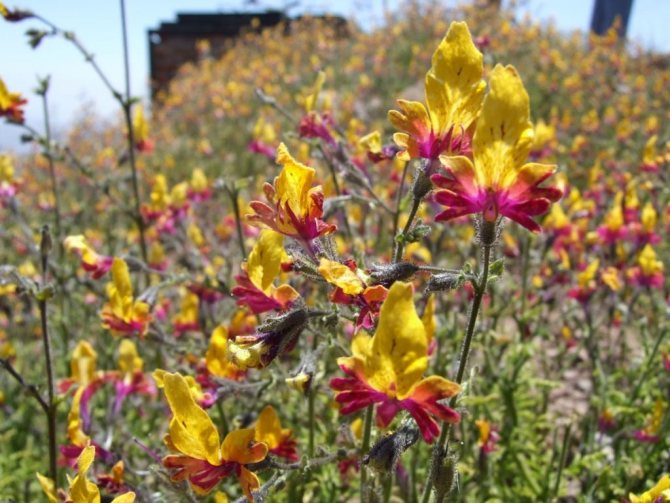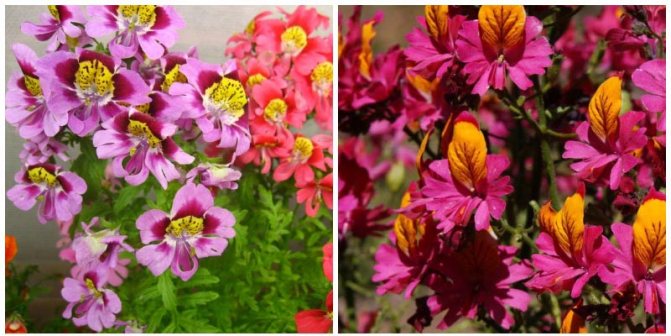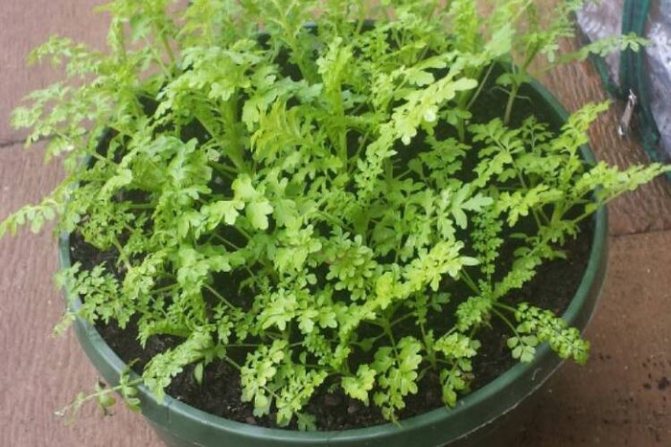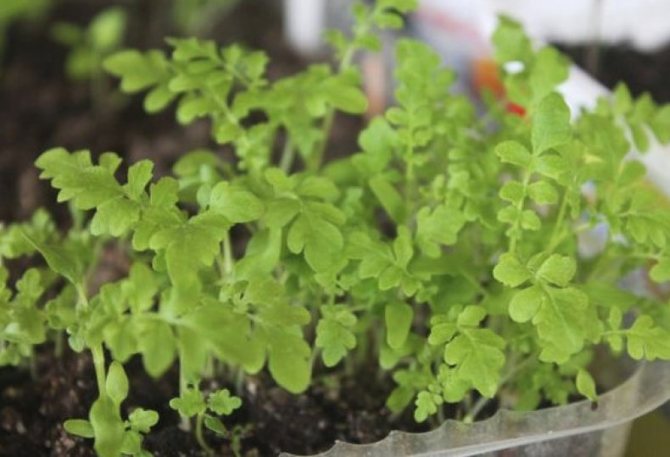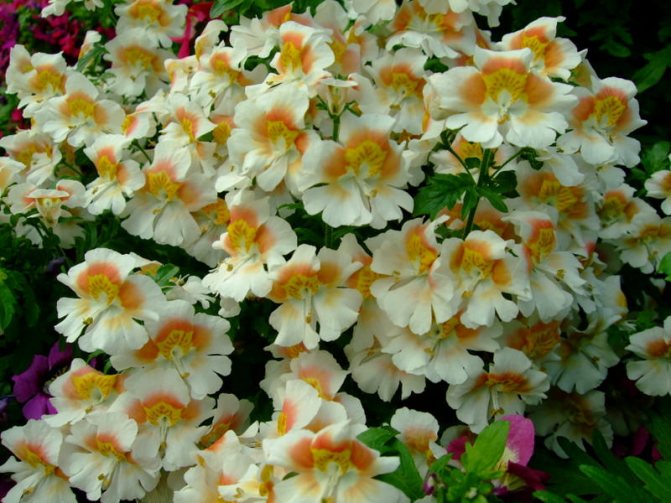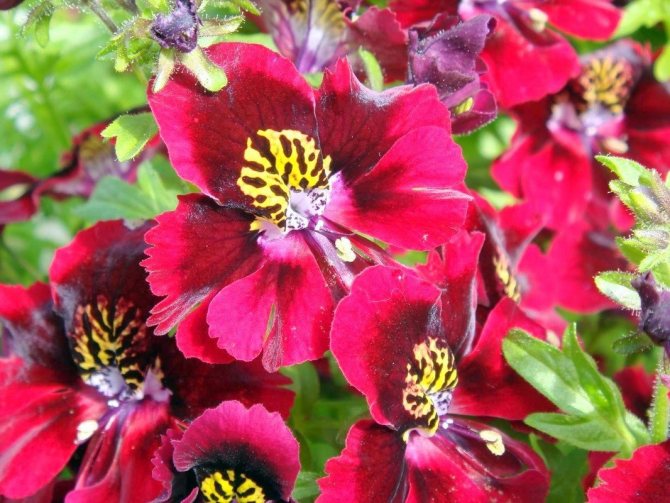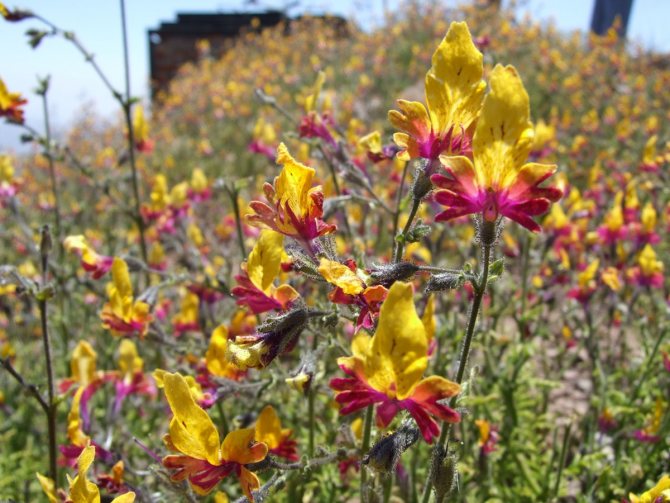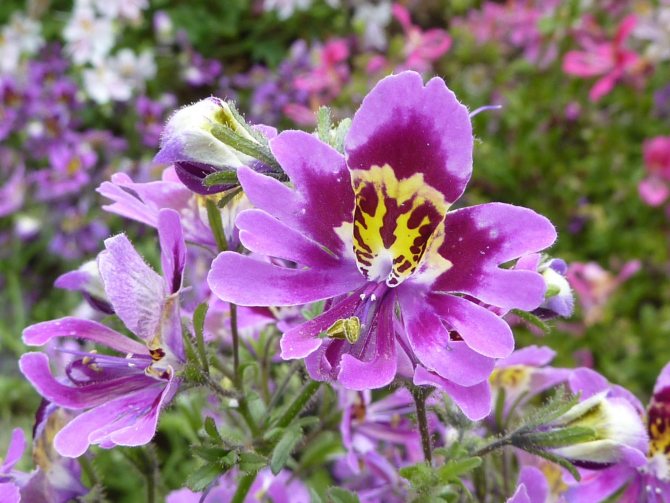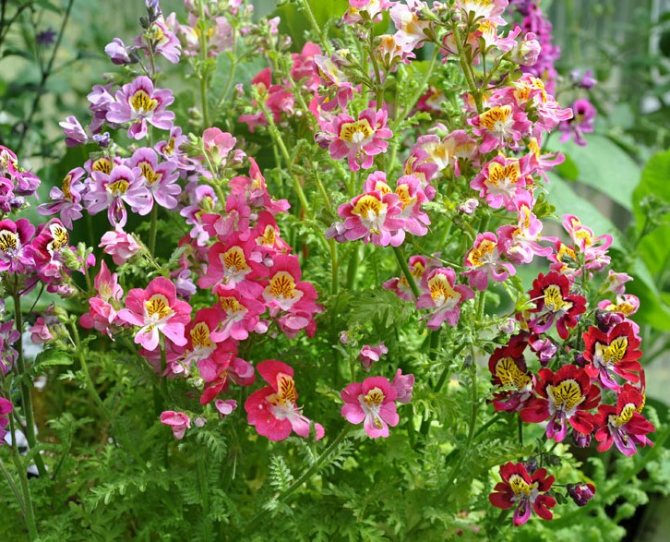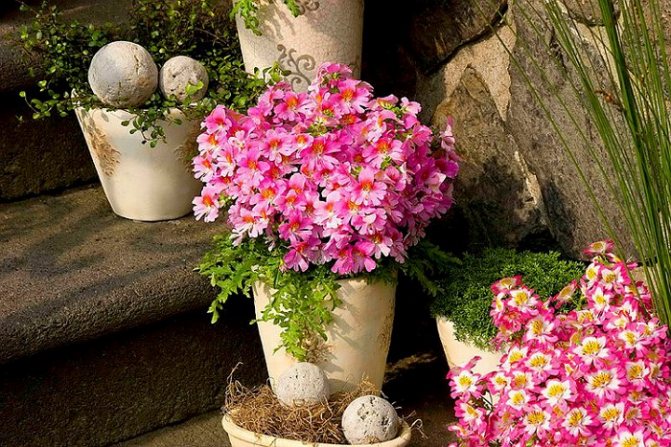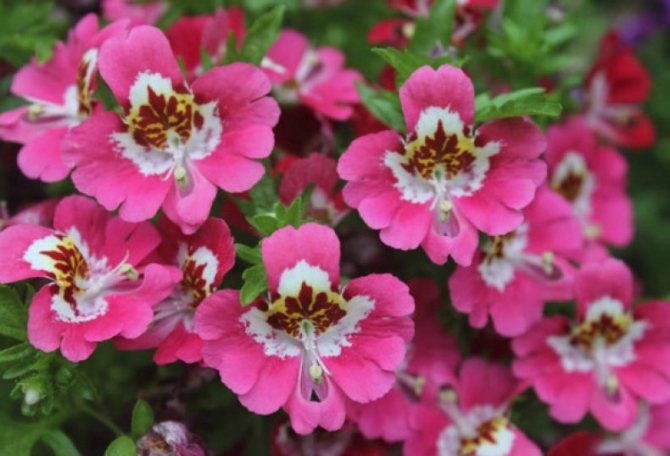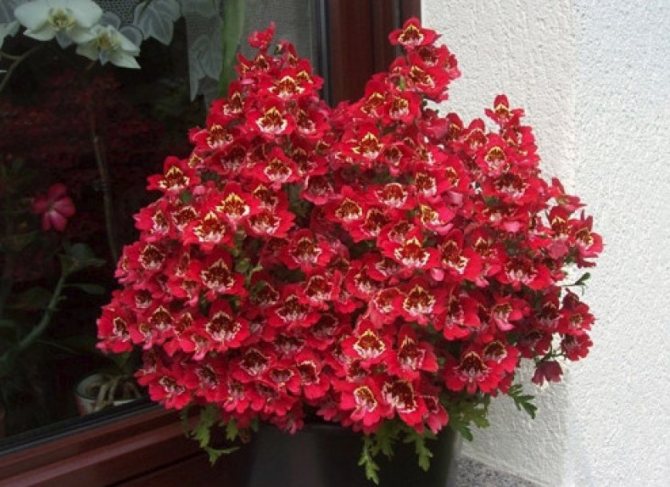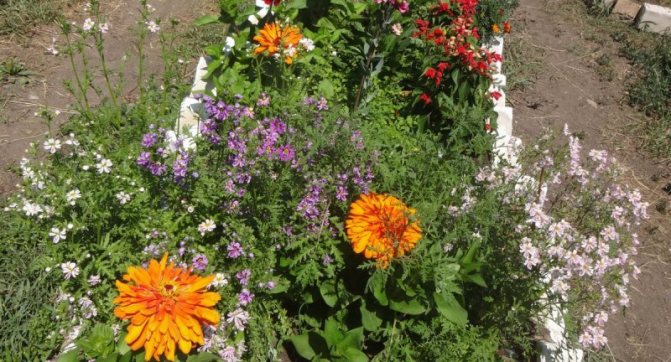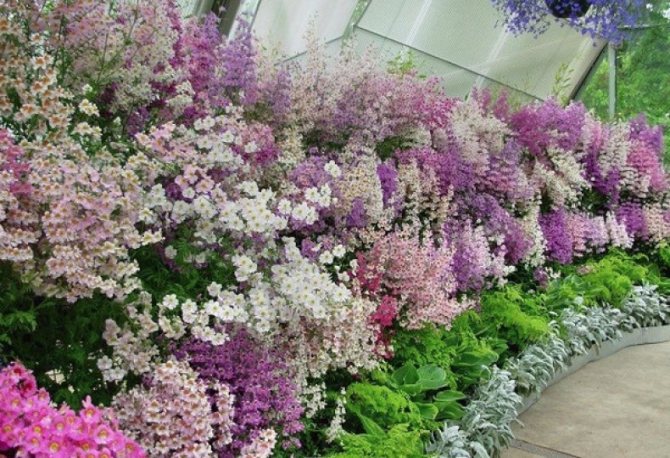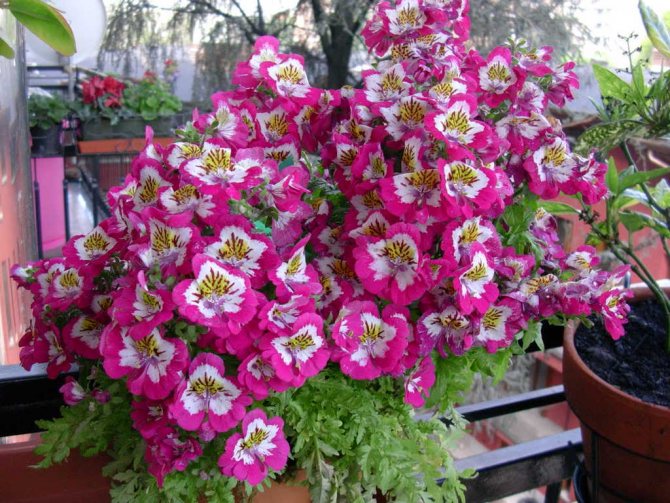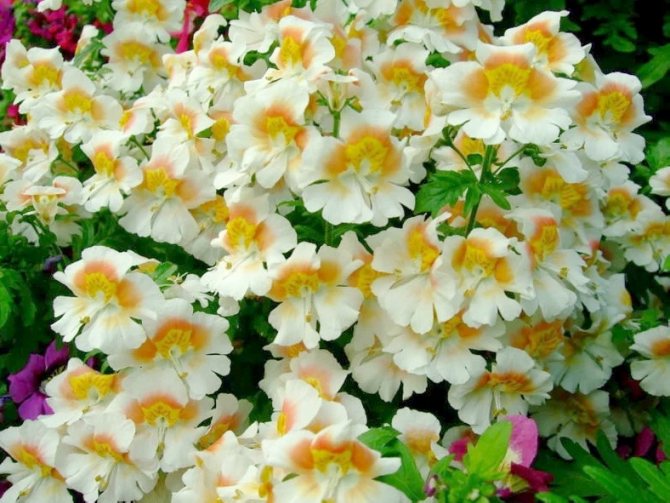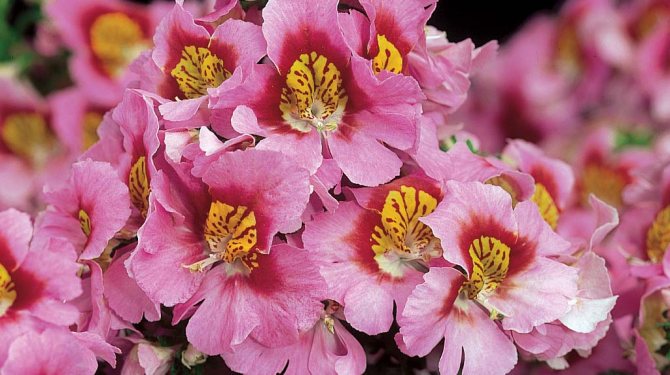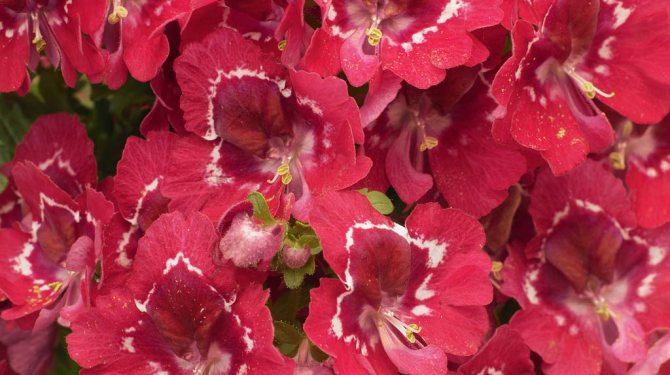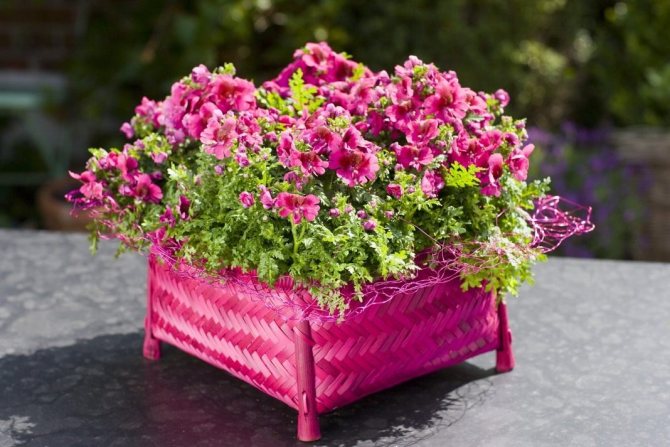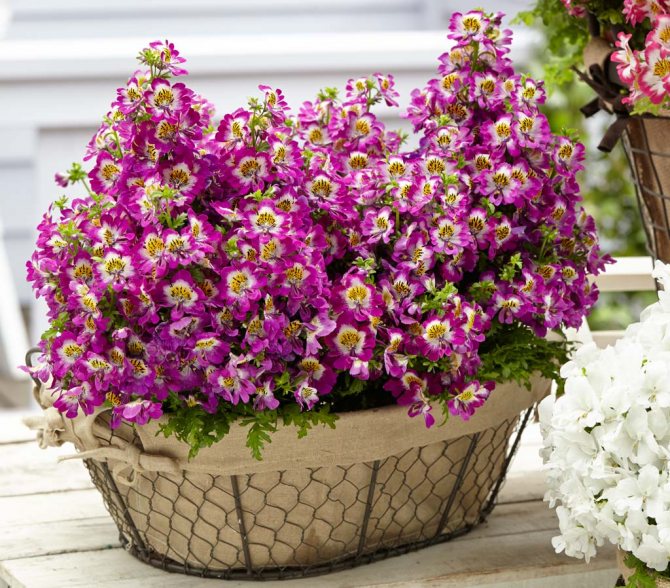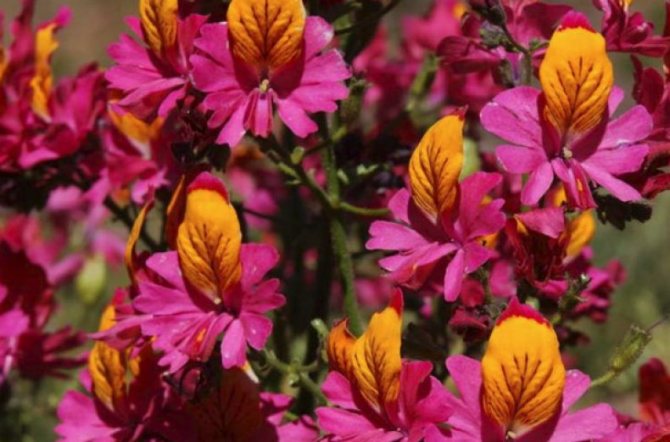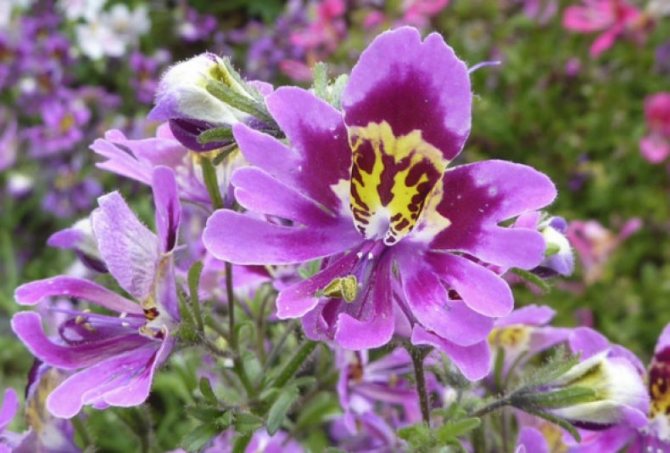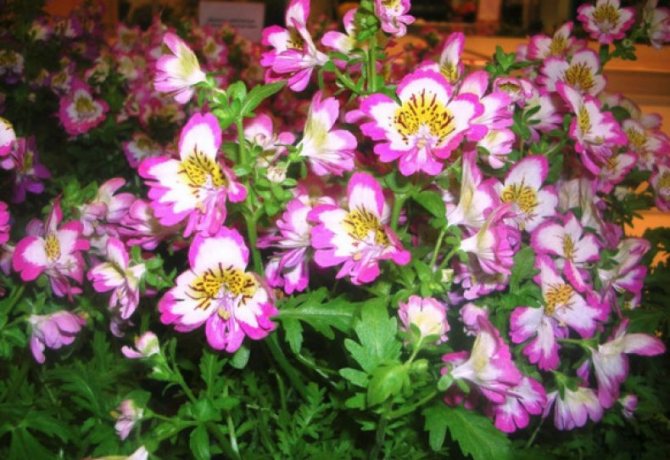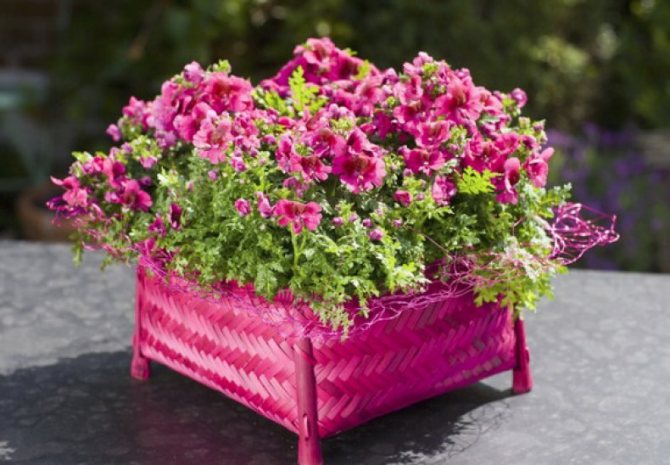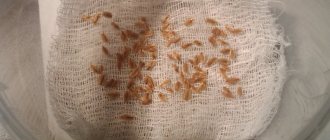Among the wide variety of garden flowers, someone likes to plant perennials more and not bother with growing seedlings every year. And for some, it is the cultivation of annual seedlings in early spring that is the most important sign of the coming spring. And the third, in general, like universal flowers that can be grown both indoors and on balconies, or you can plant them in the garden and admire their flowering throughout the warm season, in order to bring them back into the house later.
Schizanthus is just such a versatile plant. When grown in the garden, it shows, of course, more abundant and vibrant flowering, as it loves sunlight and large amounts of fertile land. But it can be severely damaged by rain and wind. And in indoor or balcony conditions, the schizanthus may not bloom so colorful and profusely, but much longer and the appearance of its flowers will always be flawless. Among other things, by its nature, it is a biennial, which means that you can admire its flowering for at least two seasons in a row. Schizanthus can be propagated exclusively by seeds. And in growing schizanthus from seeds at home, there are a number of features that will be discussed mainly later in the article.
Features of schizanthus
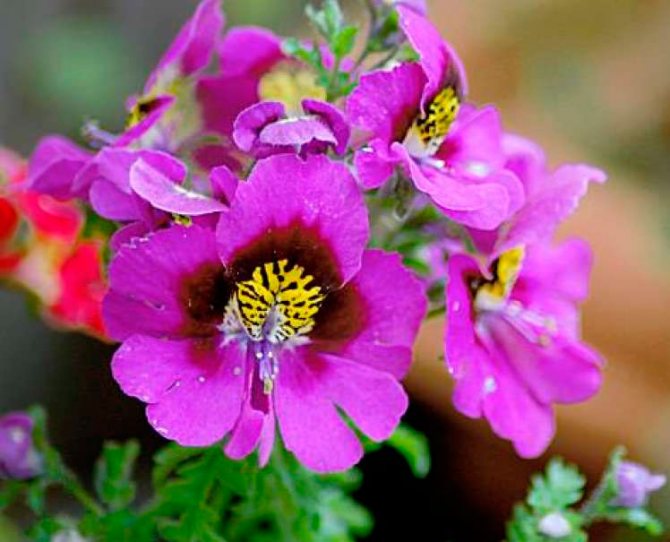
Schizanthus is a lushly flowering perennial plant, or rather a biennial plant. But in the middle latitudes, it is cultivated as an annual plant. On the surface of the shoots and foliage there is a pubescence, consisting of hairs. Bushes bloom for a very long time, or rather, from May until the first severe frosts. During flowering, the bush looks very impressive, and all thanks to the gorgeous flowers, which can have various most exotic colors. The flowers are colored red, purple, white, pink and yellow. In addition, petals are often decorated with patterns, strokes and spots. The shape of the flowers is similar to a butterfly, which is why the schizanthus is also popularly called the "butterfly flower". Inexperienced growers often confuse schizanthus with the Nemesis orchid, however, these are completely different plants belonging to different families, and only flowers are similar.
There are many varieties from which every gardener can choose the one that he will certainly like. All varieties differ not only in the color of the flowers, but also in the height of the bush. So, a plant in height can reach from 30 to 100 centimeters. Its flowers attract butterflies and bees. This plant can beautify any garden area, and it is also very popular in landscape design.
Secrets and secrets of the flower
The botanical name of the schizanthus directly indicates the shape of the flower because it consists of two Greek words that translate as "split flower". By the way, the name of the flower is often translated into Russian as schizanthus. It's just a different transcription of the same name.
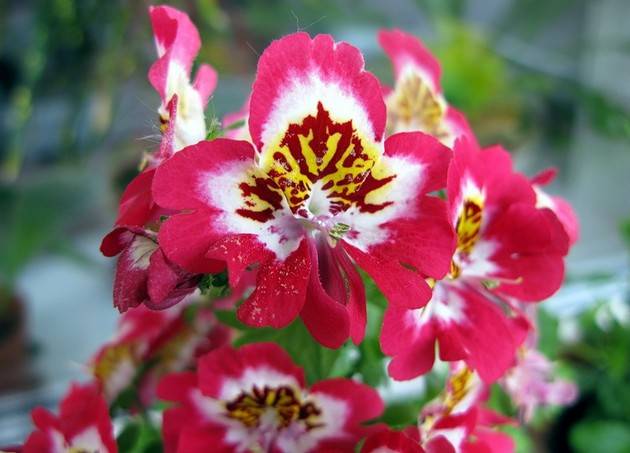

Attention! All over the world, schizanthus is better known as the "poor man's orchid" and this is more than justified.
After all, flowers so outlandish in color, reminiscent of the shape and color of exotic beauties of orchids, can be grown from just a small bag of seeds, the cost of which is no different from the seeds of ordinary annuals.
Sometimes schizanthus is called a butterfly flower.Because from the whole world of insects, only butterflies can boast of such a luxurious and fantastically varied wing color.
In general, schizanthus is a truly unique plant, concealing in itself many more mysteries and secrets, so completely unsolved. For example, it is known that when growing schizanthus seedlings, some of them lag far behind in development and look, to put it mildly, “suffocated”. This often happens with other plants, but in the schizanthus it is from these, the most weakened at the first stage of plant development, that the most amazing and unique specimens in color and splendor of flowering are obtained.
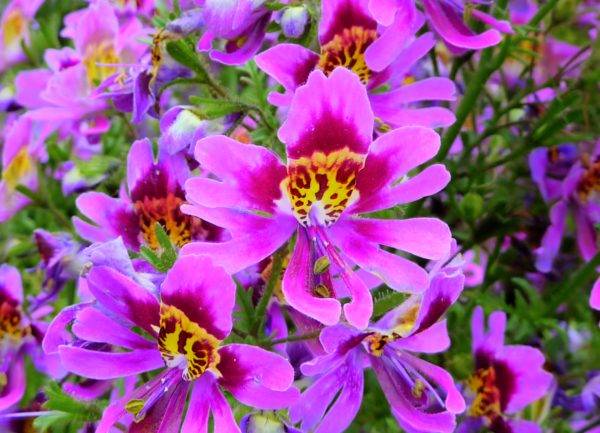

Or another riddle. Why, if schizanthus seeds are planted in late winter - early spring for seedlings, then they will bloom no earlier than 90 days, that is, by the beginning, or even by the middle of summer. And if the same seeds are sown directly into the ground in early May, then flowering can be expected in two months, that is, at the end of June - in July. Of course, this may be due to the amount and quality of sunlight, which can more than double the speed of plant development.
Growing from seeds
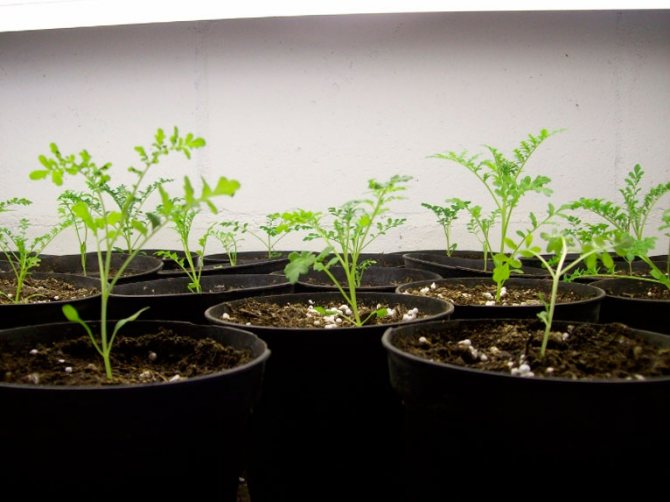

Sowing seedlings
It is possible to grow schizanthus from seeds through seedlings and in a reckless way, while doing this is quite simple, you just need to follow certain rules. Sowing seeds for seedlings is carried out in spring or autumn. If you decide to do this in the spring, then you should start sowing at the end of March or in the first days of April. Bushes grown from seeds in this case will begin to bloom around July. With the autumn sowing, which is carried out in September, the flowering of the schizanthus will begin in the last days of May.
The seedling boxes should be filled with light, well-drained nutrient-rich substrate. During sowing, seeds should be buried in the soil mixture by 0.3 centimeters. The crops are transferred to a cool place (about 18 degrees), and it is recommended to cover them with a black film on top. As a rule, seedlings appear at night after about 20 days. As soon as the weather is warm outside, it is recommended to transfer them to a well-lit balcony, they can also be placed on a sunny windowsill, it is best if it is located in the southern part of the room. Most importantly, keep in mind that the plants at this time need a lot of light. It is possible to dive a plant in separate cups only when at least three true leaf plates are formed in them. Transplanting seedlings into open soil is carried out after the returnable spring frosts are left behind. The distance between the bushes should be at least 25 centimeters.
The autumn sowing of schizanthus is good because the grown bushes will begin to bloom very early, around the end of May. In winter, the seedlings are kept in a cool but well-lit place. If necessary, they are provided with supplementary lighting using artificial lighting. In the event that some seedlings look weakened and lethargic, then in no case should they be thrown away. After the time is right, transplant them outdoors. Gardeners have noticed that it is from such weak seedlings that the most spectacular and luxuriantly flowering bushes grow.
Sowing in open ground
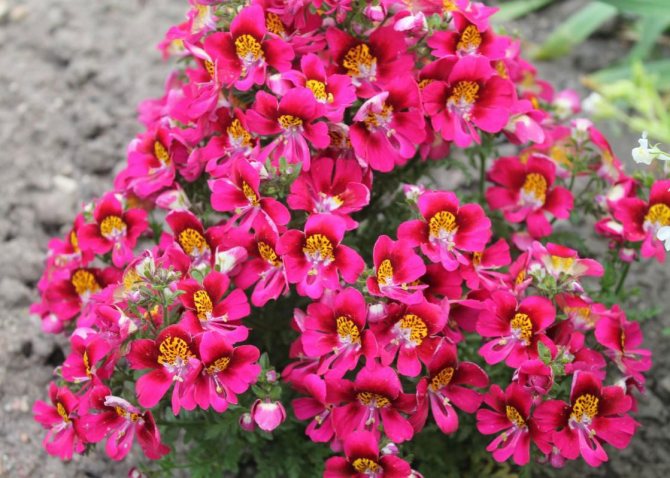

If desired, schizanthus seeds can be sown directly into open soil, but in this case, you need to be prepared for the fact that the grown bushes will begin to bloom only in July. Sowing can only be started when the weather is warm, and there is no threat of frost at night. In order for schizanthus to bloom profusely and continuously, it is recommended to sow their seeds not all at once, but to do it in several stages with a break of several days. In the event that dense shoots appear, they will need to be thinned out so that there is a distance of about 25 centimeters between the bushes. Excess seedlings can be carefully dug up and planted elsewhere.The grown and matured bushes will bloom closer to the second half of July, but they will delight you with their flowers for a very long time, as a rule, until the first autumn frosts.
Some growers are trying to grow schizanthus so that it blooms by March 8th. But you should immediately take into account that this is very difficult to do, because the bushes, as a rule, begin to bloom not earlier than May. Sowing seeds in this case is carried out in early autumn in a heated greenhouse.
The most popular among gardeners is the method of growing schizanthus through seedlings. However, those of them who sow seeds directly into open soil assure that in this case the bushes will bloom very effectively and profusely, but only from the middle of summer, but until the very frosts (most often until October).
How to grow seedlings, sowing dates
Schizanthus in natural conditions is a biennial, therefore, the sowing time is different than that of annuals. Early flowering (April-May) is obtained when sown in the last decade of August or in the first decade of September. Before planting on a ridge (flower bed), the seedlings are kept indoors, which is troublesome, but worth it - the site will look bright and beautiful in spring. If the seeds are sown in the II-III decade of February or in the first decade of March, then flowering, depending on the care, will come in June-July.
Since the seeds are small in size, the soil should be light, moisture and breathable. Soil mixes are suitable for seedlings of flower crops, tomatoes, eggplant. In order to give it looseness, vermiculite is introduced into it - about 1/8 of the volume. You can prepare the soil mixture yourself by mixing equal parts of high-moor peat, turf, sand with superphosphate and ash in small quantities. For the prevention of fungal infections, they are treated with a fungicide, a pink solution of manganese, boiling water or frozen.
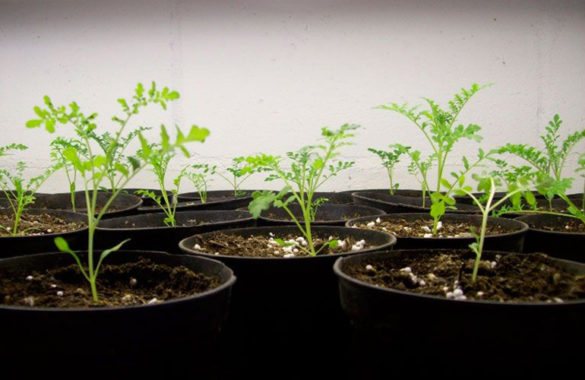

A large amount of fertilizer in the soil can provoke a lack of flowering, so this fact must be taken into account when buying ready-made soil mixtures.
How to plant:
- fill a plastic container (depth about 5 cm) with drainage holes with a mixture, moisten;
- spread the seeds over the surface or into small grooves, cover with earth (layer 2-3 mm);
- cover with a dark film and put in a cool room (18-20 ° C);
- keep the soil moist, opening the lid only to collect condensate;
- if the seeds are fresh, then the seedlings will appear quickly - for 4-5 days, in a different scenario the seedlings may appear within 25 days;
- as soon as sprouts appear, you need to provide them with maximum light, slightly lower the temperature and regularly moisten, preventing the formation of a crust on the soil, otherwise the roots may die;
- if there are 2-3 leaves, cut them apart in separate cups or put in a large box with an interval of 15 cm;
- when the seedlings take root (about 7 days), you need to feed them with a complex of mineral fertilizers, then after the formation of buds, the interval between dressings should be 1-1.5 weeks;
- pinch the tops twice - when the seedling grows up to 8 cm and up to 16 cm;
- transplant to a flower bed in May, when the soil and air warm up to 10 ° C.
When growing seedlings in autumn, a temperature of 18 ° C is required, the best option is up to 6-10 ° C. With a lack of light, the seedlings stretch out, so the lighting should be maximum. Protect from direct sun with cloth, paper. If it is difficult to create such conditions and the necessary care, then it is better not to plant in the fall.
The roots of the schizanthus grow, therefore, containers for the flower must be chosen with a diameter of 25-26 cm.On the ridge between the holes for low varieties, leave a similar distance, for medium-sized and high ones - 40 cm and 70 cm, respectively.
Landing in open ground
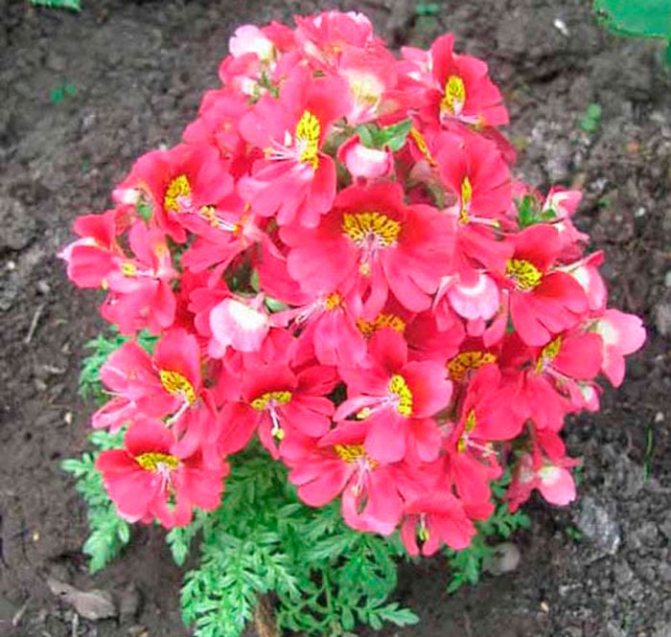

What time to plant
Planting grown schizanthus seedlings into open soil should be carried out only after the establishment of warm weather, while the threat of night frosts must be avoided. Most often, this time falls on the last days of April or May.
In order for the plant to grow and develop well, it is necessary to approach the choice of the site with all responsibility. It must have reliable protection from drafts and strong gusts of wind, as well as from prolonged rains. And also it should be borne in mind that such a culture is photophilous and for normal development it needs a large amount of sunlight, but at the same time it must be remembered that it reacts extremely negatively to too high an air temperature. In this regard, in regions with an excessively hot climate, it is recommended to choose shaded areas for planting schizanthus.
Since this flower is distinguished by a rather high demand for growing conditions, some gardeners recommend planting it not in open ground, but in pots or in pots. In this case, with the onset of hot days or long rains, it can be easily transferred for a while to another place, which will be protected from precipitation or from the scorching rays of the sun.
Also pay attention to the soil on the site, it should be slightly acidic, fertile and pass water and air well. In this regard, during the digging of the site, it is recommended to add peat and sand to the ground.
Schizanthus care
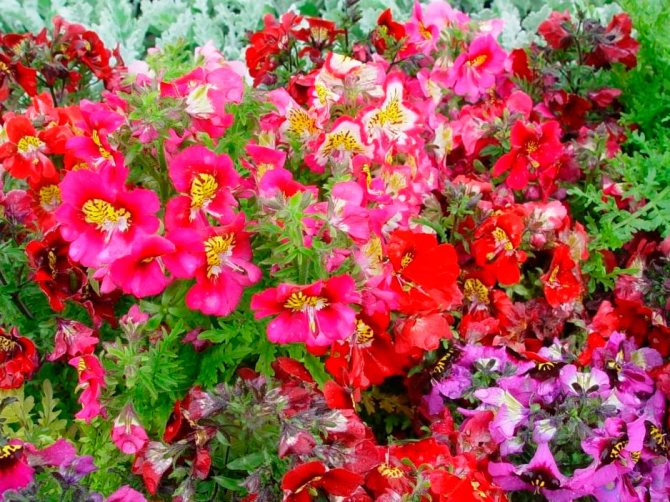

In order for the schizanthus bushes to be strong and bloom profusely and for a long time, they need to provide not only good, but also proper care.
Watering
Such a culture belongs to moisture-loving plants. In this regard, watering must be carried out systematically, while it does not matter whether the top layer of the soil is dry or not. Pour water gently under the root so that drops of water do not fall on the surface of the foliage. Water the plant with soft and warm water. Therefore, the water from the tap must first settle well for several days. However, the flower responds best of all to irrigation with rainwater, which has been heated by the rays of the sun.
Fertilizer
Top dressing should also be given special attention. Before the bush blooms, fertilizer is applied to the soil, which includes nitrogen, this contributes to the rapid growth of green mass. And when the plant blooms, then fertilizer for flowering plants must be used for feeding.
Care features
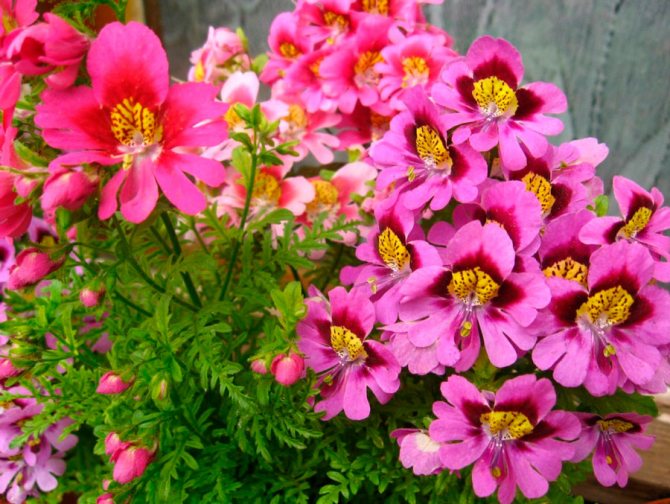

In order for the cultivation of schizanthus to be successful, it should provide:
- enough sunlight;
- systematic irrigation with suitable water;
- timely feeding.
Use in landscape design
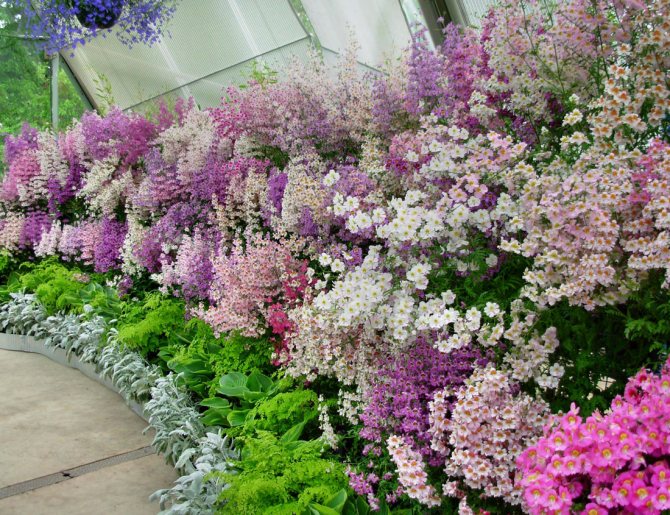

Schizanthus is very popular among landscape designers due to its bright appearance and long flowering. It is used for both group and single landings. Another flower can be planted in the foreground of flower beds or flower beds. And also they can decorate a rockery or an alpine slide. It can be combined with other flowering crops such as petunias, chamomiles, foxgloves, lobelias, pelargoniums or phlox.
This plant can also be grown in both simple and hanging planters, as well as balcony boxes or containers. Most often, low-growing varieties are used for this. They can be placed not only in the garden, but also on the terrace or on the veranda.
Diseases and pests
Most often, schizanthus is affected by diseases such as
- anthracnose;
- pityosis;
- late blight.
Regularly inspect the plants for diseases, it is better to remove the affected specimens immediately, and spray the rest with a fungicide. For prevention, you can use the same measures as for tomatoes or potatoes, since schizanthus also belongs to the nightshade family and has diseases in common with them.
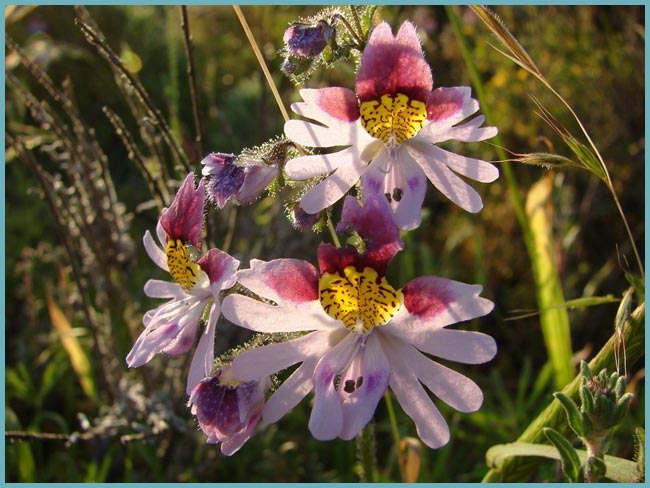

Try to eliminate pests as soon as they appear.
As for insect pests, aphids, thrips and whiteflies can most often be found on the schizanthus. Until the number of pests turns into an epidemic, measures must be taken and treated with an insecticide. After all, insects not only suck out cell sap from plants, weakening them, but also carry various flower diseases.
Types and varieties of schizanthus with photos and names
The genus Schizanthus unites 12 different species. Below will be described those that are most popular with gardeners.
Grahamii Schisanthus (S. Grahamii)
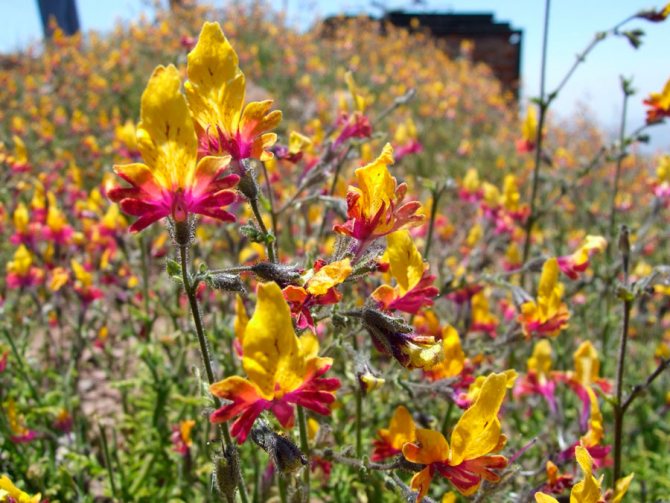

The height of this annual plant is approximately 0.6 m. The flowers are pinkish-purple in color. The petals are decorated with many purple streaks and yellow specks. Breeders have bred varieties of this plant with flowers of snow-white, pink and lilac colors. Its stem is strongly branching, and its homeland is the mountainous regions of Chile.
Schizanthus Feathery (S. Pinnatus)
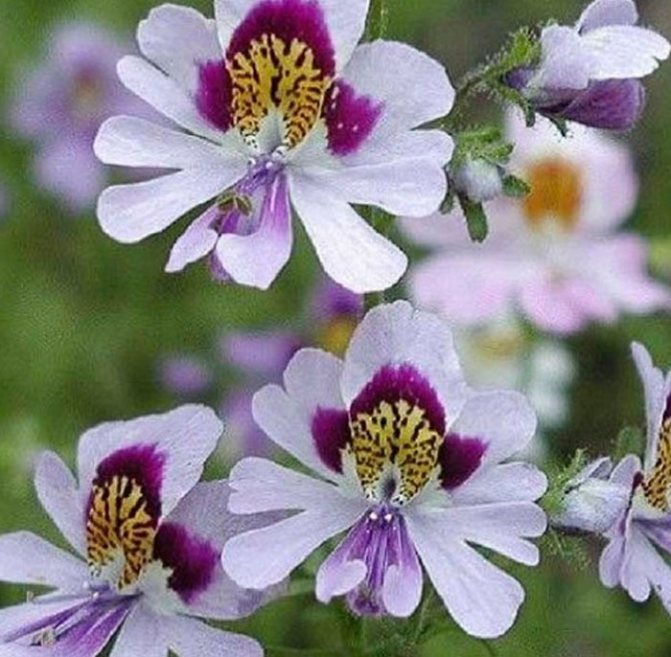

This species is an annual. The bush reaches a height of no more than half a meter. The racemose inflorescences, which are shaped like orchid inflorescences, are made up of small purple flowers. Today, there are varieties with inflorescences of deep pink and white colors. In the middle of the flower, and at the base of the lower petal, there are many strokes and spots.
Schizanthus Vizetonsky (S. Wisetonensis)
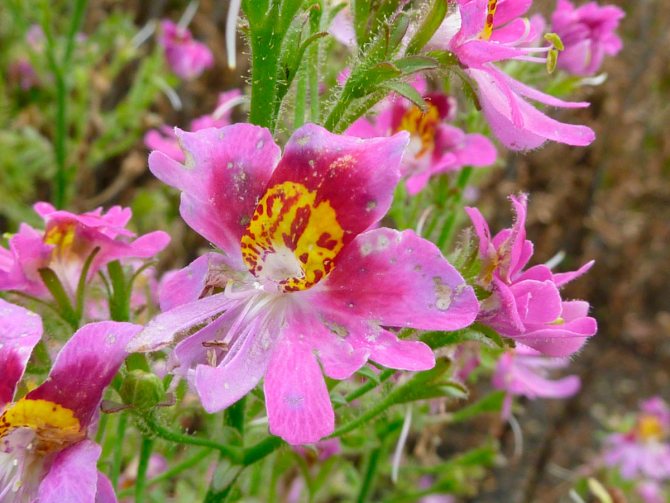

This hybrid was created using Schizanthus Feathery and Graham. The bush reaches a height of no more than 0.6 meters. Irregularly shaped flowers reach about 20 mm in diameter. They are painted in various shades of pink, and there are also plants with white inflorescences. This type of garden is most popular with gardeners, as the plant is very showy and graceful.
Various varieties of this culture are also popular among gardeners. The best ones will be described below:
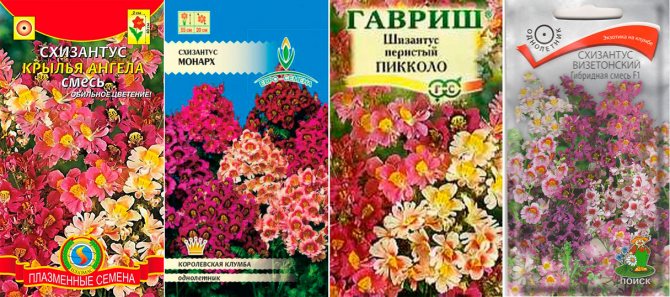

- Angel Wings... This variety belongs to the Vizetonsky schizanthus species. An annual plant can reach a height of about 0.4 meters. In the upper part of the stems, inflorescences are formed, consisting of small flowers, reaching up to 20 mm in diameter. If the plant is well looked after, then the flowering will be so lush that even the stem will not be visible due to the many beautiful flowers that can be painted pink, purple, white or carmine. The bush blooms in May, and flowering ends only in September. This variety is suitable for outdoor cultivation, as well as for growing in containers and flowerpots. It can also be grown at home.
- Monarch... This variety includes annual schizanthus. Erect shoots reach a height of about 0.4 meters. On their tops during flowering, the formation of inflorescences is observed, which include irregularly shaped flowers with a diameter of about 20 mm. They can be painted in carmine, cream, red or pink. The variety blooms magnificently and for a long time. Flowering begins in May, and ends with the first autumn frosts. You can cultivate such a plant in the garden in open soil or in containers.
- Piccollo... This annual variety belongs to the schizanthus pinnate species. The bush does not exceed 0.45 meters in height. The racemose apical inflorescences consist of many small flowers that are pink, cream or crimson in color. Such a plant can be grown not only in the open field, but also in flowerpots. The bush blooms in May, and only fades in September.
- Fiji... This exotic variety is very showy. Shoots form a pyramidal bush. The variety blooms stably, with numerous flowers tightly covering the shoots. They have a tubular shape, and reach no more than 20 mm in diameter. They can be painted pink, white or purple. A large number of spots and stripes are located on the surface of the petals.Flowers are collected in panicle inflorescences. The variety can be cultivated in a rock garden, open field or in a container.
- F1 Hybrid Blend... Hybrids belong to the Vizetonian Schizanthus species. The height of such an annual plant can reach 0.55 m. Lush bloom lasts from the first days of July to September. Panicle inflorescences consist of small flowers, reaching up to 20 mm in diameter, which have a pink, cream or crimson color, with a pattern on the petals. This hybrid mixture grows well in sunny areas outdoors, and it is also grown in beddings.
Views
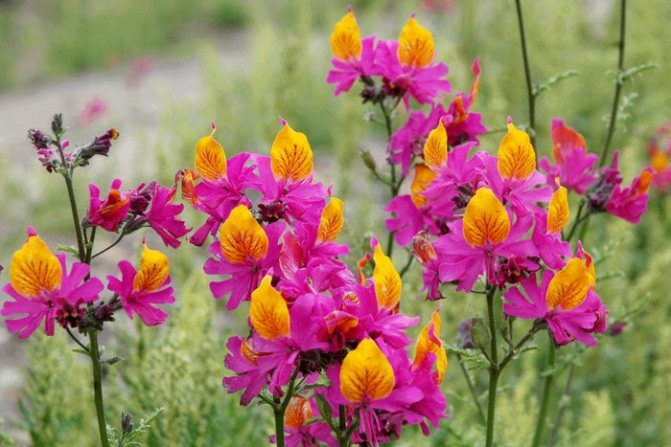

Schizanthus grahamii. Up to 60 cm tall. Shoots slightly pubescent, almost glabrous. The leaves are single or double-pinnate, the flowers are magnificent, purple-pink. There is an orange spot and purple stripes on the lower lip. Garden varieties with white, carmine and purple flowers are known.
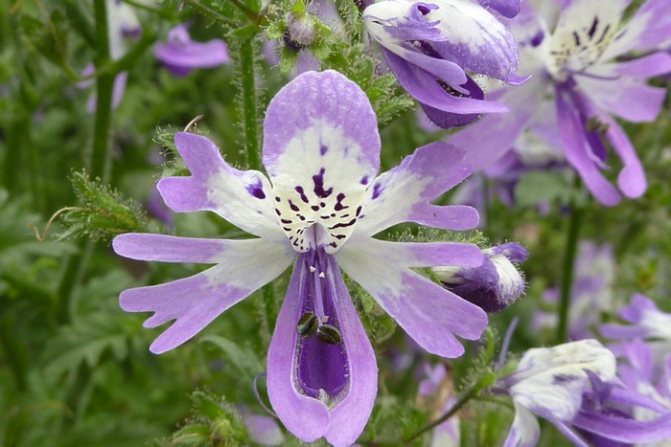

Schizanthus pinnatus (Schizanthus pinnatus). Up to 45 cm tall. Leaves are pinnately dissected three times. The flowers are two-lipped, up to 4 cm in diameter. The lower lip is purple or lilac, the upper one is lighter, with a yellow dot in the center.
Blunted schizanthus (Schizanthus retusus). Up to 50 cm tall, less hairy than previous species. It has pinnately dissected leaves and red-pink flowers, the middle part of the upper lip is orange. The flower tube is the same length as the calyx. Garden varieties have flowers of various colors.


